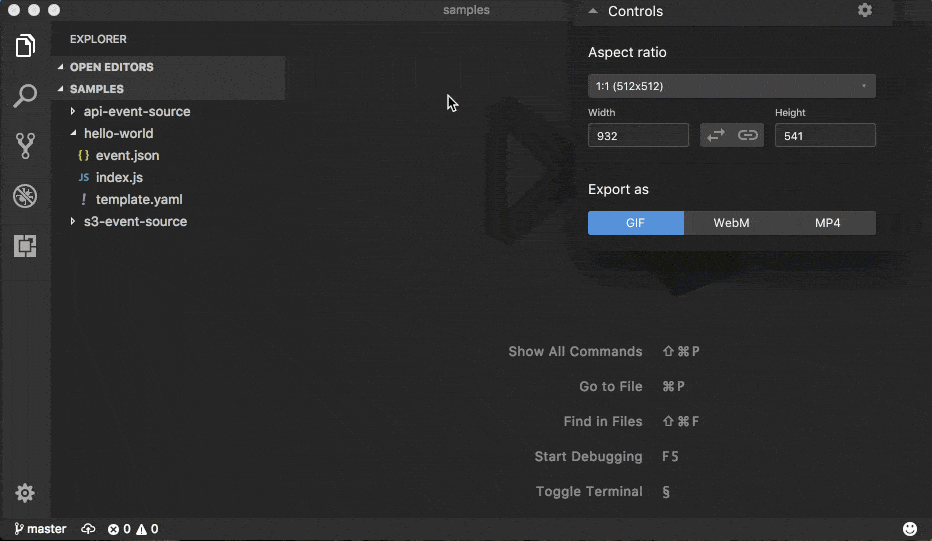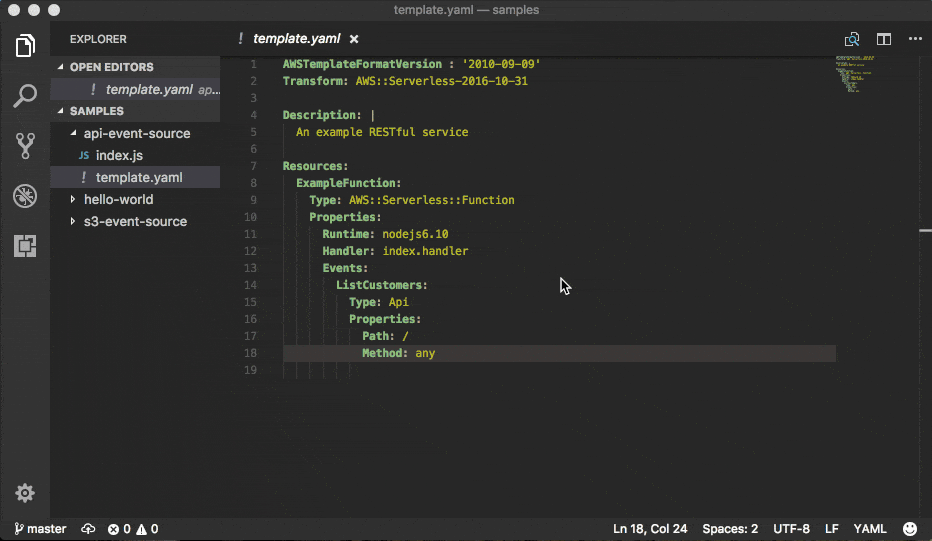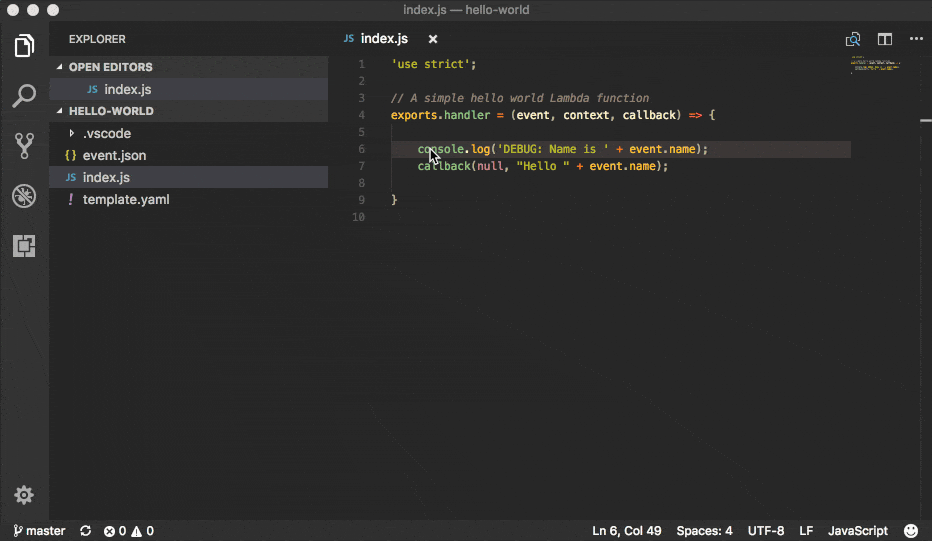Join the SAM developers channel (#samdev) on Slack to collaborate with fellow community members and the AWS SAM team.
``sam`` is the AWS CLI tool for managing Serverless applications written with AWS Serverless Application Model (SAM). SAM CLI can be used to test functions locally, start a local API Gateway from a SAM template, validate a SAM template, generate sample payloads for various event sources, and generate a SAM project in your favorite Lambda Runtime.
- SAM CLI (Beta)
- Develop and test your Lambda functions locally with
sam localand Docker - Invoke functions from known event sources such as Amazon S3, Amazon DynamoDB, Amazon Kinesis, etc.
- Start local API Gateway from a SAM template, and quickly iterate over your functions with hot-reloading
- Validate SAM templates
- Get started with boilerplate Serverless Service in your chosen Lambda
Runtime
sam init
Running Serverless projects and functions locally with SAM CLI requires
Docker to be installed and running. SAM CLI will use the DOCKER_HOST
environment variable to contact the docker daemon.
- macOS: Docker for Mac
- Windows: Docker Toolbox
- Linux: Check your distro’s package manager (e.g. yum install docker)
For macOS and Windows users: SAM CLI requires that the project directory (or any parent directory) is listed in Docker file sharing options.
Verify that docker is working, and that you can run docker commands from the CLI (e.g. ‘docker ps’). You do not need to install/fetch/pull any containers – SAM CLI will do it automatically as required.
Uninstall previous CLI Version
npm uninstall -g aws-sam-localTo upgrade to Version 0.3.0 or above, follow instructions below:
Verify Python Version is 2.7.
The easiest way to install ``sam`` is to use PIP.
pip install --user aws-sam-cliVerify the installation worked:
sam --versionTo update ``sam`` once installed via pip:
pip install --user --upgrade aws-sam-cliFirst, install Python(2.7) on your machine, then run the following:
# Clone the repository
$ git clone git@github.com/awslabs/aws-sam-cli.git
# cd into the git
$ cd aws-sam-cli
# pip install the repository
$ pip install --user -e .# Install PyEnv (https://github.com/pyenv/pyenv#installation)
$ brew update
$ brew install pyenv
# Initialize pyenv using bash_profile
$ echo -e 'if command -v pyenv 1>/dev/null 2>&1; then\n eval "$(pyenv init -)"\nfi\nexport PATH="~/.pyenv/bin:$PATH"' >> ~/.bash_profile
# or using zshrc
$ echo -e 'if command -v pyenv 1>/dev/null 2>&1; then\n eval "$(pyenv init -)"\nfi\nexport PATH="~/.pyenv/bin:$PATH"' >> ~/.zshrc
# restart the shell
$ exec "$SHELL"
# Install Python 2.7
$ pyenv install 2.7.14
$ pyenv local 2.7.14
# Install the CLI
$ pip install --user aws-sam-cli
# Verify your installation worked
$ sam –version- If you are seeing sam command not found, this is likely due to the installation using the --user and adding sam to a path that is not in your $PATH.
# Find your path Python User Base path (where Python --user will install packages/scripts)
USER_BASE_PATH="$(python -m site --user-base)"
# Add this path to your $PATH
export PATH=$USER_BASE_PATH:$PATHYou can also try an installing aws-sam-cli without --user
# Uninstall aws-sam-cli from the --user path
pip uninstall --user aws-sam-cli
pip install aws-sam-cli- [Errno 13] Permission denied If you had installed Python using
Homebrew, you might need to use
sudoto install SAM CLI:
sudo pip install aws-sam-cli- TLSV1_ALERT_PROTOCOL_VERSION:
If you get an error something similar to:
Could not fetch URL https://pypi.python.org/simple/click/: There was a problem confirming the ssl certificate: [SSL: TLSV1_ALERT_PROTOCOL_VERSION] tlsv1 alert protocol version (_ssl.c:590) - skipping
then you are probably using the default version of Python that came with your Mac. This is outdated. So make sure you install Python again using homebrew and try again:
brew install python@2Followed by:
pip install --user aws-sam-cli``sam`` requires a SAM template in order to know how to invoke your
function locally, and it’s also true for spawning API Gateway locally -
If no template is specified template.yaml will be used instead.
You can find sample SAM templates either under ``samples`` located in this repo or by visiting SAM official repository.
You can invoke your function locally by passing its SAM logical ID
and an event file. Alternatively, sam local invoke accepts stdin as
an event too.
Resources:
Ratings: # <-- Logical ID
Type: 'AWS::Serverless::Function'
...Syntax
# Invoking function with event file
$ sam local invoke "Ratings" -e event.json
# Invoking function with event via stdin
$ echo '{"message": "Hey, are you there?" }' | sam local invoke "Ratings"
# For more options
$ sam local invoke --helpTo make local development and testing of Lambda functions easier, you can generate mock/sample event payloads for the following services:
- S3
- Kinesis
- DynamoDB
- Cloudwatch Scheduled Event
- Cloudtrail
- API Gateway
Syntax
sam local generate-event <service>Also, you can invoke an individual lambda function locally from a sample event payload - Here’s an example using S3:
sam local generate-event s3 --bucket <bucket> --key <key> | sam local invoke <function logical id>For more options, see sam local generate-event --help.
sam local start-api spawns a local API Gateway to test HTTP
request/response functionality. Features hot-reloading to allow you to
quickly develop, and iterate over your functions.
Syntax
sam local start-api``sam`` will automatically find any functions within your SAM
template that have Api event sources defined, and mount them at the
defined HTTP paths.
In the example below, the Ratings function would mount
ratings.py:handler() at /ratings for GET requests.
Ratings:
Type: AWS::Serverless::Function
Properties:
Handler: ratings.handler
Runtime: python3.6
Events:
Api:
Type: Api
Properties:
Path: /ratings
Method: getBy default, SAM uses Proxy
Integration
and expects the response from your Lambda function to include one or
more of the following: statusCode, headers and/or body.
For example:
// Example of a Proxy Integration response
exports.handler = (event, context, callback) => {
callback(null, {
statusCode: 200,
headers: { "x-custom-header" : "my custom header value" },
body: "hello world"
});
}For examples in other AWS Lambda languages, see this page.
If your function does not return a valid Proxy Integration response then you will get a HTTP 500 (Internal Server Error) when accessing your function. SAM CLI will also print the following error log message to help you diagnose the problem:
ERROR: Function ExampleFunction returned an invalid response (must include one of: body, headers or statusCode in the response object)
Both sam local invoke and sam local start-api support local
debugging of your functions.
To run SAM Local with debugging support enabled, just specify
--debug-port or -d on the command line.
# Invoke a function locally in debug mode on port 5858
$ sam local invoke -d 5858 <function logical id>
# Start local API Gateway in debug mode on port 5858
$ sam local start-api -d 5858Note: If using sam local start-api, the local API Gateway will
expose all of your Lambda functions but, since you can specify a single
debug port, you can only debug one function at a time. You will need to
hit your API before SAM CLI binds to the port allowing the debugger to
connect.
Here is an example showing how to debug a NodeJS function with Microsoft Visual Studio Code:
In order to setup Visual Studio Code for debugging with AWS SAM CLI, use the following launch configuration:
{
"version": "0.2.0",
"configurations": [
{
"name": "Attach to SAM Local",
"type": "node",
"request": "attach",
"address": "localhost",
"port": 5858,
"localRoot": "${workspaceRoot}",
"remoteRoot": "/var/task",
"protocol": "legacy"
}
]
}
Note: Node.js versions below 7 (e.g. Node.js 4.3 and Node.js 6.10)
use the legacy protocol, while Node.js versions including and above
7 (e.g. Node.js 8.10) use the inspector protocol. Be sure to specify
the corresponding protocol in the protocol entry of your launch
configuration.
Unlike Node.JS and Java, Python requires you to enable remote debugging
in your Lambda function code. If you enable debugging with
--debug-port or -d for a function that uses one of the Python
runtimes, SAM CLI will just map through that port from your host machine
through to the Lambda runtime container. You will need to enable remote
debugging in your function code. To do this, use a python package such
as remote-pdb. When
configuring the host the debugger listens on in your code, make sure to
use 0.0.0.0 not 127.0.0.1 to allow Docker to map through the
port to your host machine.
Please note, due to a open
bug with
Visual Studio Code, you may get a
Debug adapter process has terminated unexpectedly error when
attempting to debug Python applications with this IDE. Please track
the GitHub
issue for
updates.
To pass additional runtime arguments when debugging your function, use
the environment variable DEBUGGER_ARGS. This will pass a string
of arguments directly into the run command SAM CLI uses to start your
function.
For example, if you want to load a debugger like iKPdb at runtime of
your Python function, you could pass the following as
DEBUGGER_ARGS:
-m ikpdb --ikpdb-port=5858 --ikpdb-working-directory=/var/task/ --ikpdb-client-working-directory=/myApp --ikpdb-address=0.0.0.0.
This would load iKPdb at runtime with the other arguments you’ve
specified. In this case, your full SAM CLI command would be:
$ DEBUGGER_ARGS="-m ikpdb --ikpdb-port=5858 --ikpdb-working-directory=/var/task/ --ikpdb-client-working-directory=/myApp --ikpdb-address=0.0.0.0" echo {} | sam local invoke -d 5858 myFunctionYou may pass debugger arguments to functions of all runtimes.
Both sam local invoke and sam local start-api support connecting
the create lambda docker containers to an existing docker network.
To connect the containers to an existing docker network, you can use the
--docker-network command-line argument or the SAM_DOCKER_NETWORK
environment variable along with the name or id of the docker network you
wish to connect to.
# Invoke a function locally and connect to a docker network
$ sam local invoke --docker-network my-custom-network <function logical id>
# Start local API Gateway and connect all containers to a docker network
$ sam local start-api --docker-network b91847306671 -d 5858Validate your templates with $ sam validate. Currently this command
will validate that the template provided is valid JSON / YAML. As with
most SAM CLI commands, it will look for a template.[yaml|yml] file
in your current working directory by default. You can specify a
different template file/location with the -t or --template
option.
Syntax
$ sam validate
<path-to-file>/template.yml is a valid SAM TemplateNote: The validate command requires AWS credentials to be configured. See IAMCreds_.
Once you have developed and tested your Serverless application locally,
you can deploy to Lambda using sam package and sam deploy
command. package command will zip your code artifacts, upload to S3
and produce a SAM file that is ready to be deployed to Lambda using AWS
CloudFormation. deploy command will deploy the packaged SAM template
to CloudFormation. Both sam package and sam deploy are identical
to their AWS CLI equivalents commands
`aws cloudformation package <http://docs.aws.amazon.com/cli/latest/reference/cloudformation/package.html>`__
and
`aws cloudformation deploy <http://docs.aws.amazon.com/cli/latest/reference/cloudformation/deploy/index.html>`__
respectively. Please consult the AWS CLI command documentation for
usage.
Example:
# Package SAM template
$ sam package --template-file sam.yaml --s3-bucket mybucket --output-template-file packaged.yaml
# Deploy packaged SAM template
$ sam deploy --template-file ./packaged.yaml --stack-name mystack --capabilities CAPABILITY_IAM- Check out our Getting Started Guide for more details
To use SAM CLI with compiled languages, such as Java that require a
packaged artifact (e.g. a JAR, or ZIP), you can specify the location of
the artifact with the AWS::Serverless::Function CodeUri property
in your SAM template.
For example:
AWSTemplateFormatVersion: 2010-09-09
Transform: AWS::Serverless-2016-10-31
Resources:
ExampleJavaFunction:
Type: AWS::Serverless::Function
Properties:
Handler: com.example.HelloWorldHandler
CodeUri: ./target/HelloWorld-1.0.jar
Runtime: java8
You should then build your JAR file using your normal build process. Please note that JAR files used with AWS Lambda should be a shaded JAR file (or uber jar) containing all of the function dependencies.
// Build the JAR file
$ mvn package shade:shade
// Invoke with SAM Local
$ echo '{ "some": "input" }' | sam local invoke
// Or start local API Gateway simulator
$ sam local start-api
You can find a full Java example in the samples/java folder
SAM CLI will invoke functions with your locally configured IAM credentials.
As with the AWS CLI and SDKs, SAM CLI will look for credentials in the following order:
- Environment Variables (
AWS_ACCESS_KEY_ID,AWS_SECRET_ACCESS_KEY). - The AWS credentials file (located at
~/.aws/credentialson Linux, macOS, or Unix, or atC:\Users\USERNAME \.aws\credentialson Windows). - Instance profile credentials (if running on Amazon EC2 with an assigned instance role).
In order to test API Gateway with a non-default profile from your AWS
credentials file append --profile <profile name> to the
start-api command:
// Test API Gateway locally with a credential profile. $ sam local start-api --profile some_profile
See this Configuring the AWS CLI for more details.
If your Lambda function uses environment variables, you can provide values for them will passed to the Docker container. Here is how you would do it:
For example, consider the SAM template snippet:
Resources:
MyFunction1:
Type: AWS::Serverless::Function
Properties:
Handler: index.handler
Runtime: nodejs4.3
Environment:
Variables:
TABLE_NAME: prodtable
BUCKET_NAME: prodbucket
MyFunction2:
Type: AWS::Serverless::Function
Properties:
Handler: app.handler
Runtime: nodejs4.3
Environment:
Variables:
STAGE: prod
TABLE_NAME: prodtableUse --env-vars argument of invoke or start-api commands to
provide a JSON file that contains values for environment variables
defined in your function. The file should be structured as follows:
{
"MyFunction1": {
"TABLE_NAME": "localtable",
"BUCKET_NAME": "testBucket"
},
"MyFunction2": {
"TABLE_NAME": "localtable",
"STAGE": "dev"
},
}$ sam local start-api --env-vars env.jsonVariables defined in your Shell’s environment will be passed to the
Docker container, if they map to a Variable in your Lambda function.
Shell variables are globally applicable to functions ie. If two
functions have a variable called TABLE_NAME, then the value for
TABLE_NAME provided through Shell’s environment will be availabe to
both functions.
Following command will make value of mytable available to both
MyFunction1 and MyFunction2
$ TABLE_NAME=mytable sam local start-apiFor greater control, you can use a combination shell variables and external environment variable file. If a variable is defined in both places, the one from the file will override the shell. Here is the order of priority, highest to lowest. Higher priority ones will override the lower.
- Environment Variable file
- Shell’s environment
- Hard-coded values from the template
When your Lambda function is invoked using SAM CLI, it sets an
environment variable AWS_SAM_LOCAL=true in the Docker container.
Your Lambda function can use this property to enable or disable
functionality that would not make sense in local development. For
example: Disable emitting metrics to CloudWatch (or) Enable verbose
logging etc.
Often, it’s useful to serve up static assets (e.g CSS/HTML/Javascript
etc) when developing a Serverless application. On AWS, this would
normally be done with CloudFront/S3. SAM CLI by default looks for a
./public/ directory in your SAM project directory and will serve up
all files from it at the root of the HTTP server when using
sam local start-api. You can override the default static asset
directory by using the -s or --static-dir command line flag. You
can also disable this behaviour completely by setting
--static-dir "".
Both invoke and start-api command allow you to pipe logs from
the function’s invocation into a file. This will be useful if you are
running automated tests against SAM CLI and want to capture logs for
analysis.
Example:
$ sam local invoke --log-file ./output.logSam CLI loads function code by mounting filesystem to a Docker Volume. As a result, The project directory must be pre-mounted on the remote host where the Docker is running.
If mounted, you can use the remote docker normally using
--docker-volume-basedir or environment variable
SAM_DOCKER_VOLUME_BASEDIR.
Example - Docker Toolbox (Windows):
When you install and run Docker Toolbox, the Linux VM with Docker is automatically installed in the virtual box.
The /c/ path for this Linux VM is automatically shared with C: on the host machine.
sam local invoke --docker-volume-basedir /c/Users/shlee322/projects/test "Ratings"- [ ] Python Versions support
- [x] Python 2.7
- [ ] Python 3.6
- [ ] Supported AWS Lambda Runtimes
- [x]
nodejs - [x]
nodejs4.3 - [x]
nodejs6.10 - [x]
nodejs8.10 - [x]
java8 - [x]
python2.7 - [x]
python3.6 - [ ]
dotnetcore1.0 - [x]
dotnetcore2.0
- [x]
- [x] AWS credential support
- [x] Debugging support
- [x] Inline Swagger support within SAM templates
- [x] Validating SAM templates locally
- [x] Generating boilerplate templates
- [x]
nodejs - [x]
nodejs4.3 - [x]
nodejs6.10 - [x]
nodejs8.10 - [x]
java8 - [x]
python2.7 - [x]
python3.6 - [x]
dotnetcore1.0 - [x]
dotnetcore2.0
- [x]
Contributions and feedback are welcome! Proposals and pull requests will be considered and responded to. For more information, see the CONTRIBUTING file.
SAM CLI uses the open source docker-lambda Docker images created by [@mhart](https://github.com/mhart).
You can find sample functions code and a SAM template used in this README under the samples folder within this repo.





